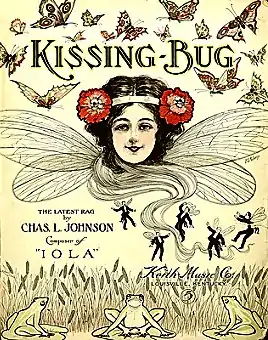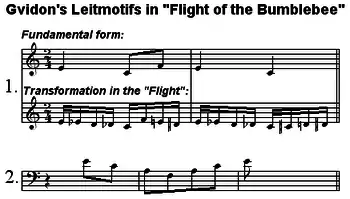
Insect names have appeared in music from Rimsky-Korsakov's "Flight of the Bumblebee" to such popular songs as "Blue-tailed Fly" and the folk song La Cucaracha which is about a cockroach. Insect groups mentioned include bees, ants, flies and the various singing insects such as cicadas, crickets, and beetles, while other songs refer to bugs in general.
Overview
Insects including bees, cicadas, crickets and grasshoppers produce sounds, whether by flying or by stridulation, attracting human interest.[1] Insect sounds have accordingly been the inspiration for a variety of forms of music. Among Western composers, Nikolai Rimsky-Korsakov imitates the quick buzzing vibrato of the bumblebee in his famous "Flight of the Bumblebee"; Edvard Grieg was inspired by flies in his Said the Gadfly to the Fly.[1][2] Popular songs with an insect theme include "Glow-Worm", "Poor Butterfly", "La Cucaracha", "The Boll Weevil", and "The Blue-Tailed Fly". Operas like Puccini's Madama Butterfly and Rousel's Le Festin de L’Araignée similarly reference arthropods.[3] Pop groups named after insects include Buddy Holly and The Crickets, The Beatles, Adam and the Ants and many others.[4] And some fictional crickets in Western popular culture, like Jiminy Cricket and Cri-Cri have been known to sing.[5][6]
In classical music
The French Renaissance composer Josquin des Prez, working in Italy, wrote a piece in the style of a frottola entitled El Grillo (lit. 'The Cricket'). It is among the most frequently sung of his works.[7]
Nikolai Rimsky-Korsakov wrote "Flight of the Bumblebee" as an orchestral interlude for his opera The Tale of Tsar Saltan, composed in 1899–1900. The piece closes Act III, Tableau 1, during which the magic Swan-Bird changes Prince Gvidon Saltanovich (the Tsar's son) into a bumblebee so that he can fly away to visit his father, who does not know that he is alive. The piece is one of the most recognizable in classical music. The fast pace of the music has given rise to its mass appeal, as well as making it difficult to play. Musicians have risen to the challenge by setting world records for the fastest performance on guitar, piano and violin.[8]

The Canadian violinist Eric Speed broke the record for the fastest performance of the "Flight of the Bumblebee" at the "Just For Laughs" festival in Montreal on 22 July 2011, playing the piece in 53 seconds.[9] The song has a direct connection to martial arts master Bruce Lee, who starred on the radio program Green Hornet. "Flight" was the show's theme music, blended with a hornet buzz created on a Theremin.[10] The play upon which the opera was based – written by Alexander Pushkin – originally had two more insect themes: the Flight of the Mosquito and the Flight of the Fly. Neither was made into musical pieces. One was made into an illustration for the original publication.[11]
Béla Bartók's bizarrely empathetic piece, From the Diary of a Fly, for piano (Mikrokosmos Vol. 6/142), attempts to depict the actions of a fly caught in a cobweb, from the fly's perspective—i.e., as related from his diary. The buzzing sounds signify the fly's desperation to escape.[12] The middle section of the Adagio religioso movement in Bartók's 1945 Piano Concerto No. 3 contains imitations of natural sounds of insect and bird calls.[13]
In popular music
"Ants Marching" is a song by the Dave Matthews Band. The song features the themes of the monotony of everyday life being like ants marching endlessly to and fro. Both the theme and the music of the song are beloved by fans, being played over 1,000 times live in concert. Dave Matthews himself once declared, "This song is our anthem."[14] The Irish folk singer Sinéad Lohan included the song "Bee In The Bottle" on her 1995 album Who Do You Think I Am.[15]
Singing insects
_(14562374898).jpg.webp)
The jazz musician and philosophy professor David Rothenberg plays duets with singing insects including cicadas, crickets, and beetles.[16]
See also
References
- 1 2 Morris, 2006.
- ↑ Thacker, Sandy (16 May 2012). "Music for the Bug Season in Canada". CBC Music. Archived from the original on 1 March 2016. Retrieved 9 April 2016.
- ↑ Hogue, Charles (1987). "Cultural Entomology". Annual Review of Entomology. Insects.org. 32: 181–199. doi:10.1146/annurev.en.32.010187.001145. Archived from the original on 17 June 2012. Retrieved 4 April 2016.
- ↑ "Insects in Music, Art and Poetry". Oregon State University. Retrieved 4 April 2016.
- ↑ Riper, A. Bowdoin Van (31 December 2010). Learning from Mickey, Donald and Walt: Essays on Disney's Edutainment Films. McFarland. ISBN 978-0-786-45957-5. Retrieved 7 November 2017.
- ↑ Billboard. Nielsen Business Media. 1985. p. 57. ISSN 0006-2510.
- ↑ Macey, Patrick. Bonfire Songs: Savonarola's Musical Legacy. Oxford: Clarendon Press. 1998. ISBN 0-19-816669-9. Page 155.
- ↑ "Rimsky-Korsakov - The Flight of the Bumblebee (Homeschool Music Appreciation)". Retrieved 21 August 2012.
- ↑ ""Eric Speed, Violinist, Flight of the Bumblebee, Nikon S9100, Montreal, 22 July 2011"". YouTube. Retrieved 2012-04-21.
- ↑ "The Green Hornet". YouTube. Retrieved 21 August 2012.
- ↑ Neff, Lyle. (1999). "The Tale of Tsar Saltan: A Centenary Appreciation of Rimski-Korsakov's Second Puškin Opera". The Pushkin Review. 2: 89–133.
- ↑ "From the Diary of a Fly, for piano (Mikrokosmos Vol. 6/142), Sz.107/6/142, BB 105/142". AllMusic. Retrieved 21 August 2012.
- ↑ Kovács, János, "Concerto for Piano and Orchestra No. 3" Booklet note for Hungaroton HCD 31888-91 (2000)
- ↑ "What song defines the Dave Matthews Band?". Retrieved 21 August 2012.
- ↑ Demalon, Tom. Insects in music at AllMusic
- ↑ "David Rothenberg: "Bug Music: How Insects Gave Us Rhythm and Noise"". The Diana Rehm Show. Retrieved 2 April 2016.
Further reading
- Coelho, Joseph (2000). "Insects in Rock & Roll Music". American Entomologist. 46 (3): 186–200. doi:10.1093/ae/46.3.186.
- Morris, Brian (2006) [2004]. Cultural Entomology. Berg. pp. 181–216. ISBN 978-1-84520-949-0.
{{cite book}}:|work=ignored (help)